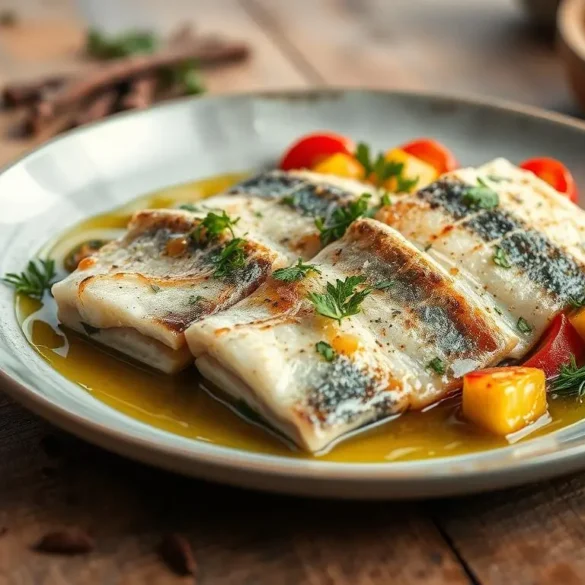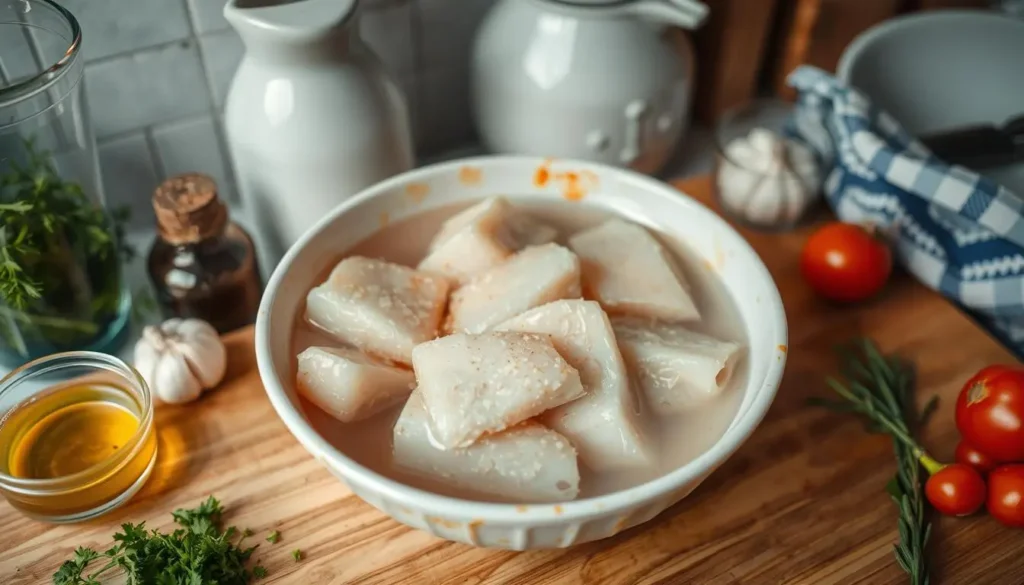
Ingredients
- 1 lb salted cod fish
- 2 tablespoons olive oil
- 1 onion, chopped
- 2 cloves garlic, minced
- 1 bell pepper, chopped
- 2 tomatoes, chopped
- 1 teaspoon paprika
- Salt to taste
- Pepper to taste
- 1/2 cup olives
- 1/2 cup capers
- 1/4 cup fresh parsley, chopped
Instructions
1. Soak the salted cod fish in water for at least 12 hours, changing the water 2-3 times to remove excess salt. 2. Drain and shred the cod into bite-sized pieces. 3. Heat olive oil in a pan over medium heat. Add onions and garlic and sauté until fragrant. 4. Add bell pepper and tomatoes, cooking until softened. 5. Stir in the shredded cod fish and cook for 10-15 minutes, allowing the flavors to meld. 6. Add paprika, olives, and capers, and season with salt and pepper. 7. Continue to cook for another 5 minutes. 8. Garnish with fresh parsley before serving.
Notes
Ensure to soak the salted cod fish thoroughly to reduce the saltiness. You can adjust the amount of olives and capers to your taste.
Table of Contents
Ever thought about how a simple way to keep fish turned it into a worldwide favorite? Salted cod fish is more than a meal. It’s a tradition that links people across the globe.
Thank you for reading this post, don't forget to subscribe!The story of salted cod fish is a journey through time and taste. It started with Portuguese fishermen and now is loved in kitchens around the world. This preserved seafood has become a key part of many cuisines.
Salted fish is more than just keeping food fresh. It’s a way to keep traditional cooking alive. It turns a simple ingredient into a special dining experience.
Key Takeaways
- Salted cod fish has deep historical roots in maritime cultures
- Preservation techniques make salted cod a versatile ingredient
- Global cuisines have embraced this unique seafood delicacy
- Salted cod represents more than food—it’s cultural heritage
- Nutritional value makes salted cod a healthy protein option
What is Salted Cod Fish?
Salted cod fish is a way to preserve fish that has been around for a long time. It turns fresh fish into a lasting food item. This is done through salting, which has shaped food traditions around the world.
The making of salted fish is a fascinating process. It turns simple seafood into a loved ingredient everywhere. It started with sea cultures and became key for sailors, traders, and coastal folks.
The History of Salted Cod
Sailors and fishermen found out salt could keep fish fresh for a long time. This changed how food was stored and traded. Salted cod fish became a vital survival method on long sea trips.
- Started in medieval European fishing communities
- Was key for trans-Atlantic trade
- Kept fish fresh without refrigeration
Understanding the Salting Process
The salting process for cod fish involves layering fresh fish with salt. This removes moisture that could spoil the fish. It makes the fish last longer and gives it a special taste.
| Salting Stage | Process Description | Duration |
|---|---|---|
| Cleaning | Remove fish scales and internal organs | 1-2 hours |
| Initial Salting | Cover fish completely with coarse salt | 24-48 hours |
| Drying | Hang fish in well-ventilated area | Several days to weeks |
“Salt has been the sailor’s best friend, transforming perishable fish into a lasting provision that could feed entire crews across vast oceans.” – Maritime Historian
The salting technique for cod fish is still loved today. It connects modern kitchens with centuries of sea history.
Nutritional Benefits of Salted Cod Fish
Salted cod fish is a nutritional powerhouse. It boosts your diet with its health benefits. This traditional seafood is not just tasty but also packed with nutrients for overall wellness.
Exploring salted cod fish reveals a protein-rich food. It changes how you plan meals and think about nutrition. The preservation process makes its nutrients even more valuable.
High Protein Content
Salted cod fish is an excellent protein source. A single serving gives you:
- Approximately 20 grams of protein per 100-gram portion
- Complete amino acid profile
- Low in saturated fats
“Protein is the building block of muscle, and salted cod fish delivers a clean, lean protein source.” – Nutrition Experts
Omega-3 Fatty Acids
The omega-3 fatty acids in salted cod fish are very beneficial. They help with heart health, brain function, and reduce inflammation.
| Nutrient | Amount per 100g | Health Benefit |
|---|---|---|
| Omega-3 | 0.3g | Cardiovascular support |
| Protein | 20g | Muscle maintenance |
| Vitamin B12 | 2.5mcg | Nervous system health |
When you make a cod fish recipe, you’re doing more than just cooking. You’re improving your nutrition. Salted cod fish is a versatile ingredient for healthy dishes.
How to Prepare Salted Cod Fish
Preparing salted cod fish needs careful steps to make it tasty. You must learn the right ways to cook it for the best flavor and texture.
First, you must learn to desalt and rehydrate the fish. This step is key to a great cod fish recipe.
Soaking Methods for Perfect Desalting
Removing salt is the first step. Here are some effective soaking methods:
- Cold water soak: Place fish in cold water, changing water every 8-12 hours
- Refrigerator method: Keep fish in clean, cold water for 24-48 hours
- Temperature matters: Use cold water to prevent bacterial growth
Essential Cooking Techniques
After desalting, you can try different cooking methods:
| Cooking Method | Flavor Profile | Cooking Time |
|---|---|---|
| Poaching | Delicate, tender | 8-10 minutes |
| Baking | Crisp exterior | 15-20 minutes |
| Pan-frying | Crispy, golden | 4-6 minutes per side |
Pro tip: Pat the fish dry before cooking. This helps get the best texture and prevents too much moisture.
“The key to perfect salted cod is patience in preparation and precision in cooking.” – Culinary Experts
Popular Dishes Featuring Salted Cod Fish
Salted cod fish dishes take you on a journey through many cultures. Each recipe turns this preserved seafood into a feast for the senses. From Portuguese kitchens to French bistros, these dishes show the fish’s versatility and rich flavors.
Looking into these classic dishes shows how adaptable salted cod is. Chefs use many techniques to make delicious meals that showcase the fish’s unique taste.
Bacalhau à Brás: A Portuguese Delicacy
Bacalhau à Brás is a key Spanish bacalao recipe from Portugal. It’s a comforting mix of shredded salted cod, crispy straw potatoes, onions, and scrambled eggs. The ingredients come together beautifully, showing off traditional cooking skills.
- Shredded salted cod
- Crispy straw potatoes
- Caramelized onions
- Scrambled eggs
- Garnished with parsley
Brandade de Morue: French Culinary Elegance
Brandade de Morue is another standout salted cod dish from French cuisine. It’s a creamy mix of salt cod, olive oil, and sometimes potatoes or bread. It’s a rich spread or main course that needs skill to get right.
“Brandade de Morue transforms simple ingredients into a culinary masterpiece” – French Culinary Magazine
Both dishes show how different cultures turn salted cod into a gourmet treat. Whether you’re having Bacalhau à Brás or Brandade de Morue, these recipes give a taste of the world of salted cod dishes.
How to Choose the Best Salted Cod
Choosing the right salted cod fish can make your cooking better. Knowing the differences in this traditional seafood helps you pick the best for your recipe.
When you’re looking for salted cod fish, several things affect its quality and taste. You need to pay close attention and understand what makes a great product.
Types of Salted Cod Variations
- Portuguese style (thicker cut)
- Norwegian clipfish
- Mediterranean preparation
- Canadian Atlantic salt cod
Quality Indicators for Salted Cod
| Quality Aspect | Positive Indicators | Red Flags |
|---|---|---|
| Color | Uniform white to light beige | Yellow or brown discoloration |
| Texture | Firm and consistent | Soft or mushy appearance |
| Salt Content | Balanced, not overpowering | Excessive saltiness |
Experts say to buy salted cod from trusted seafood markets or specialty stores. Look for vacuum-sealed packages. They keep the fish fresh and prevent moisture from getting in.
“The secret to an outstanding salted cod dish lies in selecting the highest quality fish.” – Culinary Experts
When making your best salted cod fish recipe, follow these expert tips. They will help you make a delicious and true seafood dish.
Storing Salted Cod Fish
Keeping salted cod fish fresh is important. It helps keep the fish good for longer. Whether you cook at home or in a restaurant, knowing how to store it well is key.

Refrigeration Techniques
Temperature and moisture are crucial when storing salted cod fish. Unopened packages can stay in a cool, dry place. But once you open it, move it to the fridge right away.
- Store in an airtight container
- Keep away from direct light
- Maintain consistent refrigeration temperature
Shelf Life Expectations
The shelf life of salted fish depends on how you store it. If stored right, salted cod can last months. But, always check it regularly.
| Storage Method | Unopened Shelf Life | Opened Shelf Life |
|---|---|---|
| Refrigerated | 12-18 months | 3-5 days |
| Frozen | 24 months | 2-3 months |
Freezing Salted Cod Fish
Freezing is a great way to keep salted cod fish fresh longer. Wrap the fish tightly in moisture-proof packaging before freezing. When you’re ready to use it, thaw it slowly in the fridge to keep its taste and texture.
“The key to great salted cod is not just in the preparation, but in the careful storage.” – Culinary Expert
Look out for signs of spoilage like bad smells, color changes, or a slimy feel. These signs mean it’s time to throw the fish away for safety.
Global Popularity of Salted Cod
Salted cod has traveled far beyond its original maritime roots. It has become a cherished ingredient in cuisines around the world. From the bustling markets of Portugal to the vibrant kitchens of the Caribbean, this preserved fish has woven itself into the cultural fabric of numerous regions.
Regional Culinary Journeys
The global journey of salted cod reveals remarkable diversity in preparation and appreciation. Caribbean salted cod stands out as a particularly distinctive culinary tradition. Each island presents unique interpretations of this versatile ingredient.
- Portugal: Bacalhau is considered a national treasure
- Spain: Spanish bacalao recipe features in countless traditional dishes
- Norway: Crucial to historic preservation techniques
- Brazil: Essential in multiple festive and everyday recipes
Cultural Significance
Beyond mere sustenance, salted cod represents a deep connection to maritime heritage. Coastal communities developed intricate preservation methods. These methods transformed this fish into a cultural symbol of resilience and creativity.
“Salted cod is more than food—it’s a narrative of survival, trade, and culinary innovation.”
| Region | Signature Dish | Cultural Importance |
|---|---|---|
| Portugal | Bacalhau à Brás | National culinary identity |
| Caribbean | Salt Fish Fritters | Colonial and indigenous fusion |
| Spain | Brandade | Festive and family gatherings |
The global popularity of salted cod shows how a single ingredient can connect cultures. It does this through shared culinary experiences.
Pairing and Serving Suggestions
To make your salted cod fish dishes stand out, think about what to pair and how to present them. Salted cod has a unique taste that needs the right sides and flavors to shine.
Best Accompaniments
Choosing the right sides for your salted cod fish recipe is key. Look for things that balance its salty taste. Here are some great options:
- Roasted potatoes with herbs
- Crisp green salads
- Steamed vegetables
- Crusty artisan bread
- Creamy polenta
Wine Pairing Recommendations
Choosing the right wine can elevate your salted cod dishes. White wines with a crisp, acidic taste are perfect. They help cut through the fish’s rich texture.
| Wine Type | Flavor Profile | Best Match |
|---|---|---|
| Sauvignon Blanc | Citrusy, Crisp | Grilled Salted Cod |
| Albariño | Mineral, Bright | Baked Salted Cod Dishes |
| Pinot Grigio | Light, Refreshing | Fried Salted Cod |
Pro tip: Serve your salted cod fish dishes with a wedge of lemon to brighten the flavors and cut through the saltiness.
“The art of serving salted cod is in understanding its subtle nuances and complementing its robust character.” – Culinary Expert
Cooking Tips for Perfect Salted Cod
Learning to cook salted cod needs special techniques and careful prep. This fish is delicate and requires attention to detail. It turns from a preserved ingredient into a tasty meal.
Avoiding Common Cooking Mistakes
When making a cod fish recipe, some mistakes can ruin your dish. Here are the main errors to avoid:
- Skipping the desalting process
- Overcooking the fish
- Using the wrong water temperature
- Not removing excess salt
Expert Flavor Enhancement Strategies
Improve your salted cod with these expert tips:
- Soak cod in cold water for 24-48 hours, changing water often
- Pat fish dry before cooking for a crispy exterior
- Add aromatic herbs like parsley, thyme, and bay leaves
“The secret to perfect salted cod is patience and precise preparation.” – Mediterranean Culinary Expert
Recommended Cooking Methods
| Cooking Method | Recommended Temperature | Cooking Time |
|---|---|---|
| Baking | 375°F | 12-15 minutes |
| Poaching | 160°F | 8-10 minutes |
| Grilling | 400°F | 6-8 minutes |
By using these tips, you’ll make your salted cod into a dish that wows everyone.
Salted Cod in Culinary Traditions
Salted cod has become a key part of global cuisine, telling stories across cultures. It’s found in Mediterranean kitchens and Caribbean homes, loved by many. Each place has made its own version of the Spanish bacalao recipe, creating unique dishes.
Mediterranean Influences
Mediterranean countries have mastered salted cod over the years. In Spain, chefs use it in many dishes, like bacalao al pil pil and bacalao a la vizcaína. These recipes show off the fish’s strong taste.
Greece and Italy also love salted cod, adding their own twist to it. They make it a part of their special dishes.
Latin American Dishes
In the Caribbean, salted cod is a big part of the culture, thanks to old trade routes and cultural mix. In Puerto Rico, you can find bacalaítos, salt cod fritters, on the streets. Brazil and Portugal also have their own ways of cooking it, making it a part of their food heritage.
Learning about these traditions shows us the power of salted cod. It’s not just a fish; it’s a symbol of creativity and connection between people and their food.
FAQ
How long do I need to soak salted cod before cooking?
Soaking salted cod takes 24-48 hours. Change the water 3-4 times a day. Thicker fish might need 48 hours to remove salt well.
Can I freeze salted cod fish?
Yes, you can freeze salted cod. Unopened packages can go in the freezer for 6 months. Rehydrated fish should be wrapped tightly and frozen for 2-3 months. Always thaw it in the fridge.
What are the best dishes to make with salted cod?
Popular dishes include Portuguese Bacalhau à Brás and Spanish Brandade de Morue. You can also make Caribbean salt fish fritters and Italian baccalà. These dishes show how versatile salted cod is.
Is salted cod healthy?
Salted cod is rich in protein and omega-3s. It’s low in calories and full of nutrients like vitamin B12. But, it’s high in sodium. Soaking reduces the salt before cooking.
How can I tell if salted cod has gone bad?
Look for bad signs like a bad smell, color change, or sliminess. Good salted cod is firm and smells slightly salty. It can last months if stored right, but check it before cooking.
What’s the best way to remove salt from salted cod?
Soak it in cold water, changing it every 4-6 hours. Use a big container and keep it cold. The water should be clear before cooking. Some use warm water first to speed up the process.
Can I use salted cod in different types of cuisine?
Yes! Salted cod is used in many cuisines. It’s great in stews, fritters, casseroles, salads, and even pasta or rice dishes.


